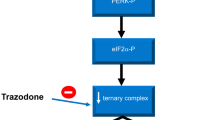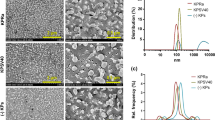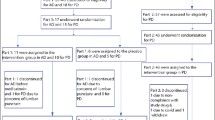Abstract
Intranasal administration, which bypasses the blood–brain barrier and minimizes systemic exposure, is a non-invasive alternative for targeted drug delivery to the brain. While identification of metal dysregulation in Alzheimer’s brain has led to the development of therapeutic metal-binding agents, targeting to the brain has remained an issue. The purpose of this study was to both determine concentrations of deferoxamine (DFO), a high-affinity iron chelator, reaching the brains of mice after intranasal administration and to determine its efficacy in a mouse model of spatial memory loss. Intranasal administration of DFO (2.4 mg) labeled with 59Fe (75 μCi) to C57 mice resulted in micromolar concentrations at 30 min within brain parenchyma. After 3 months of intranasal DFO treatment, 2.4 mg three times per week, 48-week-old APP/PS1 mice had significantly reduced escape latencies in Morris water maze compared to vehicle-treated mice. This is the first report that intranasal DFO improves spatial memory in a mouse model of Alzheimer’s disease and demonstrates that intranasal DFO reaches the brain in therapeutic doses.



Similar content being viewed by others
References
Vyas TK, Shahiwala A, Marathe S, Misra A. Intranasal drug delivery for brain targeting. Curr Drug Deliv. 2005;2:165–75.
Costantino HR, Illum L, Brandt G, Johnson PH, Quay SC. Intranasal delivery: physicochemical and therapeutic aspects. Int J Pharm. 2007;337:1–24.
Nonaka N, Farr SA, Kageyama H, Shioda S, Banks WA. Delivery of galanin-like peptide to the brain: targeting with intranasal delivery and cyclodextrins. J Pharmacol Exp Ther. 2008;325:513–9.
Dhanda DS, Frey WHI, Leopold D, Kompella UB. Approaches for drug deposition in the human olfactory epithelium. Drug Deliv. 2005;5:64–72.
Charlton ST, Whetstone J, Fayinka ST, Read KD, Illum L, Davis SS. Evaluation of direct transport pathways of glycine receptor antagonists and an angiotensin antagonist from the nasal cavity to the central nervous system in the rat model. Pharm Res. 2008;25:1531–43.
Thorne RG, Hanson LR, Ross TM, Tung D, Frey 2nd WH. Delivery of interferon-beta to the monkey nervous system following intranasal administration. Neuroscience. 2008;152:785–97.
Benedict C, Hallschmid M, Schultes B, Born J, Kern W. Intranasal insulin to improve memory function in humans. Neuroendocrinology. 2007;86:136–42.
Hanson LR, Martinez PM, Taheri S, Kamsheh L, Mignot E, Frey WHI. Intranasal administration of hypocretin 1 (Orexin A) bypasses the blood–brain barrier & targets the brain: a new strategy for the treatment of narcolepsy. Drug Deliv Tech. 2004;4:81–6.
Benedict C, Hallschmid M, Hatke A, Schultes B, Fehm HL, Born J, et al. Intranasal insulin improves memory in humans. Psychoneuroendocrinology. 2004;29:1326–34.
Reger MA, Watson GS, Frey 2nd WH, Baker LD, Cholerton B, Keeling ML, et al. Effects of intranasal insulin on cognition in memory-impaired older adults: modulation by APOE genotype. Neurobiol Aging. 2006;27:451–8.
Craft S, Baker LD, Montine TJ, Minoshima S, Watson GS, Claxton A, et al. Intranasal insulin therapy for alzheimer disease and amnestic mild cognitive impairment: a pilot clinical trial. Arch Neurol. 2011; (in press)
Domingo JL. Aluminum and other metals in Alzheimer’s disease: a review of potential therapy with chelating agents. J Alzheimers Dis. 2006;10:331–41.
Crouch PJ, White AR, Bush AI. The modulation of metal bio-availability as a therapeutic strategy for the treatment of Alzheimer’s disease. FEBS J. 2007;274:3775–83.
Bush AI. Drug development based on the metals hypothesis of Alzheimer’s disease. J Alzheimers Dis. 2008;15:223–40.
Almli LM, Hamrick SE, Koshy AA, Tauber MG, Ferriero DM. Multiple pathways of neuroprotection against oxidative stress and excitotoxic injury in immature primary hippocampal neurons. Brain Research Dev Brain Res. 2001;132:121–9.
Altamura S, Muckenthaler MU. Iron toxicity in diseases of aging: Alzheimer’s disease, Parkinson’s disease and atherosclerosis. J Alzheimers Dis. 2009;16:879–95.
Cherny RA, Atwood CS, Xilinas ME, Gray DN, Jones WD, McLean CA, et al. Treatment with a copper-zinc chelator markedly and rapidly inhibits beta-amyloid accumulation in Alzheimer’s disease transgenic mice. Neuron. 2001;30:665–76.
Regland B, Lehmann W, Abedini I, Blennow K, Jonsson M, Karlsson I, et al. Treatment of Alzheimer’s disease with clioquinol. Dement Geriatr Cogn Disord. 2001;12:408–14.
Ritchie CW, Bush AI, Mackinnon A, Macfarlane S, Mastwyk M, MacGregor L, et al. Metal-protein attenuation with iodochlorhydroxyquin (clioquinol) targeting Abeta amyloid deposition and toxicity in Alzheimer disease: a pilot phase 2 clinical trial. Arch Neurol. 2003;60:1685–91.
Sampson E, Jenagaratnam L, McShane R. Metal protein attenuating compounds for the treatment of alzheimer’s disease. Cochrane Database Syst Rev. 2008;CD005380.
Schafer S, Pajonk FG, Multhaup G, Bayer TA. Copper and clioquinol treatment in young APP transgenic and wild-type mice: effects on life expectancy, body weight, and metal-ion levels. J Mol Med. 2007;85:405–13.
Lannfelt L, Blennow K, Zetterberg H, Batsman S, Ames D, Harrison J, et al. Safety, efficacy, and biomarker findings of PBT2 in targeting Abeta as a modifying therapy for Alzheimer’s disease: a phase IIa, double-blind, randomised, placebo-controlled trial. Lancet Neurol. 2008;7:779–86.
de Lima MN, Dias CP, Torres JP, Dornelles A, Garcia VA, Scalco FS, et al. Reversion of age-related recognition memory impairment by iron chelation in rats. Neurobiol Aging. 2008;29:1052–9.
Crapper McLachlan DR, Dalton AJ, Kruck TP, Bell MY, Smith WL, Kalow W, et al. Intramuscular desferrioxamine in patients with Alzheimer’s disease. Lancet. 1991;337:1304–8.
McLachlan DR, Fraser PE, Dalton AJ. Aluminium and the pathogenesis of Alzheimer’s disease: a summary of evidence. CIBA Found Symp. 1992;169:87–98. discussion 99–108.
Hanson LR, Roeytenberg A, Martinez PM, Coppes VG, Sweet DC, Rao RJ, et al. Intranasal deferoxamine provides increased brain exposure and significant protection in rat ischemic stroke. J Pharmacol Exp Ther. 2009;330:679–86.
Kan WC, Chien CC, Wu CC, Su SB, Hwang JC, Wang HY. Comparison of low-dose deferoxamine versus standard-dose deferoxamine for treatment of aluminium overload among haemodialysis patients. Nephrol Dial Transplant. 2010;25:1604–8.
Halliwell B. Protection against tissue damage in vivo by desferrioxamine: what is its mechanism of action? Free Radic Biol Med. 1989;7:645–51.
Wu Y, Li X, Xie W, Jankovic J, Le W, Pan T. Neuroprotection of deferoxamine on rotenone-induced injury via accumulation of HIF-1alpha and induction of autophagy in SH-SY5Y cells. Neurochem Int. 2010;57:198–205.
Hadaczek P, Yamashita Y, Mirek H, Tamas L, Bohn MC, Noble C, et al. The “perivascular pump” driven by arterial pulsation is a powerful mechanism for the distribution of therapeutic molecules within the brain. Mol Ther. 2006;14:69–78.
Thorne RG, Frey 2nd WH. Delivery of neurotrophic factors to the central nervous system: pharmacokinetic considerations. Clin Pharmacokinet. 2001;40:907–46.
Dhuria SV, Hanson LR, Frey 2nd WH. Intranasal delivery to the central nervous system: mechanisms and experimental considerations. J Pharm Sci. 2010;99:1654–73.
Chen XQ, Fawcett JR, Rahman YE, Ala TA, Frey IW. Delivery of nerve growth factor to the brain via the olfactory pathway. J Alzheimers Dis. 1998;1:35–44.
Trinchese F, Liu S, Battaglia F, Walter S, Mathews PM, Arancio O. Progressive age-related development of Alzheimer-like pathology in APP/PS1 mice. Ann Neurol. 2004;55:801–14.
Berardi N, Braschi C, Capsoni S, Cattaneo A, Maffei L. Environmental enrichment delays the onset of memory deficits and reduces neuropathological hallmarks in a mouse model of Alzheimer-like neurodegeneration. J Alzheimers Dis. 2007;11:359–70.
Costa DA, Cracchiolo JR, Bachstetter AD, Hughes TF, Bales KR, Paul SM, et al. Enrichment improves cognition in AD mice by amyloid-related and unrelated mechanisms. Neurobiol Aging. 2007;28:831–44.
Jankowsky JL, Melnikova T, Fadale DJ, Xu GM, Slunt HH, Gonzales V, et al. Environmental enrichment mitigates cognitive deficits in a mouse model of Alzheimer’s disease. J Neurosci. 2005;25:5217–24.
House E, Collingwood J, Khan A, Korchazkina O, Berthon G, Exley C. Aluminium, iron, zinc and copper influence the in vitro formation of amyloid fibrils of Abeta42 in a manner which may have consequences for metal chelation therapy in Alzheimer’s disease. J Alzheimers Dis. 2004;6:291–301.
Westerman MA, Cooper-Blacketer D, Mariash A, Kotilinek L, Kawarabayashi T, Younkin LH, et al. The relationship between Abeta and memory in the Tg2576 mouse model of Alzheimer’s disease. J Neurosci. 2002;22:1858–67.
Hershko C, Weatherall DJ. Iron-chelating therapy. Crit Rev Clin Lab Sci. 1988;26:303–45.
Kontoghiorghes GJ. Comparative efficacy and toxicity of desferrioxamine, deferiprone and other iron and aluminium chelating drugs. Toxicol Lett. 1995;80:1–18.
Mu D, Chang YS, Vexler ZS, Ferriero DM. Hypoxia-inducible factor 1alpha and erythropoietin upregulation with deferoxamine salvage after neonatal stroke. Exp Neurol. 2005;195:407–15.
Freret T, Valable S, Chazalviel L, Saulnier R, Mackenzie ET, Petit E, et al. Delayed administration of deferoxamine reduces brain damage and promotes functional recovery after transient focal cerebral ischemia in the rat. Eur J Neurosci. 2006;23:1757–65.
Prass K, Ruscher K, Karsch M, Isaev N, Megow D, Priller J, et al. Desferrioxamine induces delayed tolerance against cerebral ischemia in vivo and in vitro. J Cereb Blood Flow Metab. 2002;22:520–5.
Gordon GS, Ambruso DR, Robinson WA, Githens JH. Intranasal administration of deferoxamine to iron overloaded patients. Am J Med Sci. 1989;297:280–4.
Acknowledgments
Thanks to Julian Tokarev and Kate Faltesek for their help with the behavior tests. Thanks to Thomas Flottemesch for assistance with the statistical analyses. Funding for this work was received from the HealthPartners Research Foundation Internal Grant 05-097 and private donations made to the Alzheimer’s Research Center at Regions Hospital.
Ethical standards
All experimental procedures were in compliance with the Guide for the Care and Use of Laboratory Animals and approved by the AAALAC accredited Health Partners Research Foundation’s Animal Care and Use Program.
Declaration of interest
LRH, SSP, and WHF are inventors on patents owned by the HealthPartners Research Foundation related to intranasal deferoxamine. All authors, except SSP, were employed by the HealthPartners Research Foundation during the time this work was conducted.
Author information
Authors and Affiliations
Corresponding author
Rights and permissions
About this article
Cite this article
Hanson, L.R., Fine, J.M., Renner, D.B. et al. Intranasal delivery of deferoxamine reduces spatial memory loss in APP/PS1 mice. Drug Deliv. and Transl. Res. 2, 160–168 (2012). https://doi.org/10.1007/s13346-011-0050-2
Published:
Issue Date:
DOI: https://doi.org/10.1007/s13346-011-0050-2




